�
VOLUME 1.
PART 1.
1 Measurement.
2 Motion Along a Straight Line.
3 Vectors.
4 Motion in Two and Three Dimensions.
5 Force and Motion — I.
6 Force and Motion — II.
7 Kinetic Energy and Work.
8 Potential Energy and Conservation of Energy.
9 Center of Mass and Linear Momentum.
10 Rotation.
11 Rolling, Torque, and Angular Momentum.
PART 2.
12 Equilibrium and Elasticity.
13 Gravitation.
14 Fluids.
15 Oscillations.
16 Waves — I.
17 Waves — II.
18 Temperature, Heat, and the First Law of Thermodynamics.
19 The Kinetic Theory of Gases.
20 Entropy and the Second Law of Thermodynamics.
VOLUME 2.
PART 3.
21 Electric Charge.
22 Electric Fields.
23 Gauss’ Law.
24 Electric Potential.
25 Capacitance.
26 Current and Resistance.
27 Circuits.
28 Magnetic Fields.
29 Magnetic Fields Due to Currents.
30 Induction and Inductance.
31 Electromagnetic Oscillations and Alternating Current.
32 Maxwell’s Equations; Magnetism of Matter.
PART 4.
33 Electromagnetic Waves.
34 Images.
35 Interference.
36 Diffraction.
37 Relativity.
PART 5.
38 Photons and Matter Waves.
39 More About Matter Waves.
40 All About Atoms.
41 Conduction of Electricity in Solids.
42 Nuclear Physics.
43 Energy from the Nucleus.
44 Quarks, Leptons, and the Big Bang.
�
Chapter 1
1. Various geometric formulas are given in Appendix E.
(a) Expressing the radius of the Earth as
)(
6.37 10 m 10 km m
R
=
=
×
(
)
3
−
6
6.37 10 km,
×
3
3
s
=
=
×
A
4
= π
Rπ π
2
2 (6.37 10 km)
its circumference is
(b) The surface area of Earth is
(c) The volume of Earth is
2. The conversion factors are: 1 gry 1/10 line
inch. The factors imply that
4
Rπ
3
4
π
3
4
= π
V
R
=
=
=
(
(
3
2
=
4.00 10 km.
×
4
6.37
×
3
10 km
)2
=
5.10 10 km .
2
×
8
6.37 10 km
×
3
)3
=
1.08 10 km .
3
×
12
, 1 line 1/12 inch
=
and 1 point = 1/72
1 gry = (1/10)(1/12)(72 points) = 0.60 point.
Thus, 1 gry2 = (0.60 point)2 = 0.36 point2, which means that
3. The metric prefixes (micro, pico, nano, …) are given for ready reference on the inside
front cover of the textbook (see also Table 1–2).
(a) Since 1 km = 1 × 103 m and 1 m = 1 × 106 μm,
0.50 gry = 0.18 point
.
2
2
1km 10 m 10 m 10 m m 10 m.
μ
μ
=
=
=
3
6
9
3
)(
The given measurement is 1.0 km (two significant figures), which implies our result
should be written as 1.0 × 109 μm.
(b) We calculate the number of microns in 1 centimeter. Since 1 cm = 10−2 m,
1cm = 10 m = 10 m 10 m m 10 m.
μ
μ
=
2
−
−
6
4
2
We conclude that the fraction of one centimeter equal to 1.0 μm is 1.0 × 10−4.
(c) Since 1 yd = (3 ft)(0.3048 m/ft) = 0.9144 m,
)
)
(
(
)(
1
�
2
CHAPTER 1
1.0 yd = 0.91m 10 m m 9.1 10 m.
μ
=
×
5
(
μ
6
)(
)
4. (a) Using the conversion factors 1 inch = 2.54 cm exactly and 6 picas = 1 inch, we
obtain
0.80 cm = 0.80 cm
(
)
⎛
⎜
⎝
1 inch
6 picas
2.54 cm 1 inch
⎞⎛
⎟⎜
⎠⎝
⎞
⎟
⎠
≈
1.9 picas.
(b) With 12 points = 1 pica, we have
0.80 cm = 0.80 cm
(
)
201.168 m
5. Given that 1 furlong
the relevant conversion factors to be
=
6 picas
1 inch
⎞⎛
⎟⎜
2.54 cm 1 inch
⎠⎝
⎛
⎜
⎝
⎞⎛
⎟⎜
⎠⎝
12 points
1 pica
⎞
⎟
⎠
≈
23 points.
, 1 rod 5.0292 m
=
and 1chain
=
20.117 m
, we find
1.0 furlong
=
201.168 m (201.168 m )
=
and
1.0 furlong
=
201.168 m (201.168 m )
=
1 rod
5.0292 m
=
40 rods,
1 chain
20.117 m
=
10 chains
.
Note the cancellation of m (meters), the unwanted unit. Using the given conversion
factors, we find
(a) the distance d in rods to be
d =
4.0 furlongs
=
(
4.0 furlongs
) 40 rods
1 furlong
(b) and that distance in chains to be
d =
4.0 furlongs
=
(
4.0 furlongs
)10 chains
1 furlong
=
160 rods,
=
40 chains.
6. We make use of Table 1-6.
(a) We look at the first (“cahiz”) column: 1 fanega is equivalent to what amount of cahiz?
We note from the already completed part of the table that 1 cahiz equals a dozen fanega.
Thus, 1 fanega = 1
12 cahiz, or 8.33 × 10−2 cahiz. Similarly, “1 cahiz = 48 cuartilla” (in the
already completed part) implies that 1 cuartilla = 1
48 cahiz, or 2.08 × 10−2 cahiz.
Continuing in this way, the remaining entries in the first column are 6.94 × 10−3 and
3.47 10−×
3
.
�
3
2 = 0.500 for the last entry.
(b) In the second (“fanega”) column, we find 0.250, 8.33 × 10−2, and 4.17 × 10−2 for the
last three entries.
(c) In the third (“cuartilla”) column, we obtain 0.333 and 0.167 for the last two entries.
(d) Finally, in the fourth (“almude”) column, we get 1
(e) Since the conversion table indicates that 1 almude is equivalent to 2 medios, our
amount of 7.00 almudes must be equal to 14.0 medios.
(f) Using the value (1 almude = 6.94 × 10−3 cahiz) found in part (a), we conclude that
7.00 almudes is equivalent to 4.86 × 10−2 cahiz.
(g) Since each decimeter is 0.1 meter, then 55.501 cubic decimeters is equal to 0.055501
m3 or 55501 cm3. Thus, 7.00 almudes = 7.00
12 (55501 cm3) = 3.24 × 104 cm3.
7. We use the conversion factors found in Appendix D.
Since 2 in. = (1/6) ft, the volume of water that fell during the storm is
Thus,
1 acre ft = (43,560 ft ) ft = 43,560 ft
(26 km )(3281ft/km) (1/6 ft)
12 fanega = 7.00
(26 km )(1/6 ft)
V =
=
4.66 10 ft .
3
×
7
3
=
2
⋅
⋅
2
2
2
V =
.
4 66
.
4 3560
×
×
10
3
ft
10
7
ft acre ft
4
⋅
3
=
.
11
×
3
10
acre ft.
⋅
8. From Fig. 1-4, we see that 212 S is equivalent to 258 W and 212 – 32 = 180 S is
equivalent to 216 – 60 = 156 Z. The information allows us to convert S to W or Z.
(a) In units of W, we have
50.0 S
=
(
50.0 S
(b) In units of Z, we have
) 258 W
⎛
⎜
212 S
⎝
⎞
⎟
⎠
=
60.8 W
50.0 S
=
(
50.0 S
9. The volume of ice is given by the product of the semicircular surface area and the
thickness. The area of the semicircle is A = πr2/2, where r is the radius. Therefore, the
volume is
) 156 Z
⎛
⎜
180 S
⎝
⎞
⎟
⎠
=
43.3 Z
�
4
V
=
CHAPTER 1
r z
2
where z is the ice thickness. Since there are 103 m in 1 km and 102 cm in 1 m, we have
r
=
(
2000km
)
⎛
⎜
⎝
3
10 m 10 cm
1km
2
1m
⎞ ⎛
⎟ ⎜
⎠ ⎝
=
⎞
⎟
⎠
2000 10 cm.
×
5
π
2
In these units, the thickness becomes
z
=
3000m 3000m
=
(
)
⎛
⎜
⎝
10 cm
2
1m
=
⎞
⎟
⎠
3000 10 cm
×
2
t
C
=
t
B
+
,
t
B
=
t
A
−
2
7
594
7
33
40
662
5
.
These are used in obtaining the following results.
(a) We find
t
′
B
−
t
B
=
when t'A − tA = 600 s.
33
40
(
t
′
A
−
t
A
)
=
495 s
(
π
2
)
2
)
(
5
2
V
22
°
×
=
×
×
=
cm .
3
= ° before resetting one's watch by 1.0 h.
2000 10 cm 3000 10 cm 1.9 10
which yields
10. Since a change of longitude equal to 360° corresponds to a 24 hour change, then one
expects to change longitude by360 / 24 15
11. (a) Presuming that a French decimal day is equivalent to a regular day, then the ratio
of weeks is simply 10/7 or (to 3 significant figures) 1.43.
(b) In a regular day, there are 86400 seconds, but in the French system described in the
problem, there would be 105 seconds. The ratio is therefore 0.864.
12. A day is equivalent to 86400 seconds and a meter is equivalent to a million
micrometers, so
6
b
gc
10
m
37
.
μ
gb
b
86400
14
day
h
m m
s day
g
μ=
31
.
m s
.
13. The time on any of these clocks is a straight-line function of that on another, with
slopes ≠ 1 and y-intercepts ≠ 0. From the data in the figure we deduce
�
5
=
=
b
b
t
t
C
=
s.
g
t
B
2
7
2
7
t
′ −
C
′ −
B
141
g
495
(b) We obtain
(c) Clock B reads tB = (33/40)(400) − (662/5) ≈ 198 s when clock A reads tA = 400 s.
(d) From tC = 15 = (2/7)tB + (594/7), we get tB ≈ −245 s.
14. The metric prefixes (micro (μ), pico, nano, …) are given for ready reference on the
inside front cover of the textbook (also Table 1–2).
(a)
1 century
μ
=
(
10
6
−
century
)
100 y
1 century
⎛
⎜
⎝
⎞ ⎛
⎟ ⎜
⎠ ⎝
365 day
1 y
⎞ ⎛
⎟ ⎜
⎠ ⎝
24 h
1 day
⎞ ⎛
⎟ ⎜
⎠ ⎝
60 min
1 h
⎞
⎟
⎠
=
52.6 min.
(b) The percent difference is therefore
52.6 min
−
50 min
52.6 min
=
4.9%.
15. A week is 7 days, each of which has 24 hours, and an hour is equivalent to 3600
seconds. Thus, two weeks (a fortnight) is 1209600 s. By definition of the micro prefix,
this is roughly 1.21 × 1012 μs.
16. We denote the pulsar rotation rate f (for frequency).
1 rotation
f
=
1.55780644887275 10
×
−
3
s
(a) Multiplying f by the time-interval t = 7.00 days (which is equivalent to 604800 s, if
we ignore significant figure considerations for a moment), we obtain the number of
rotations:
N
=
1 rotation
1.55780644887275 10
×
3
−
s
⎛
⎜
⎝
⎞
⎟
⎠
(
604800 s
)
=
388238218.4
which should now be rounded to 3.88 × 108 rotations since the time-interval was
specified in the problem to three significant figures.
(b) We note that the problem specifies the exact number of pulsar revolutions (one
million). In this case, our unknown is t, and an equation similar to the one we set up in
part (a) takes the form N = ft, or
1 10
×
6
⎛
= ⎜
⎝
1 rotation
1.55780644887275 10
×
3
−
s
t
⎞
⎟
⎠
�
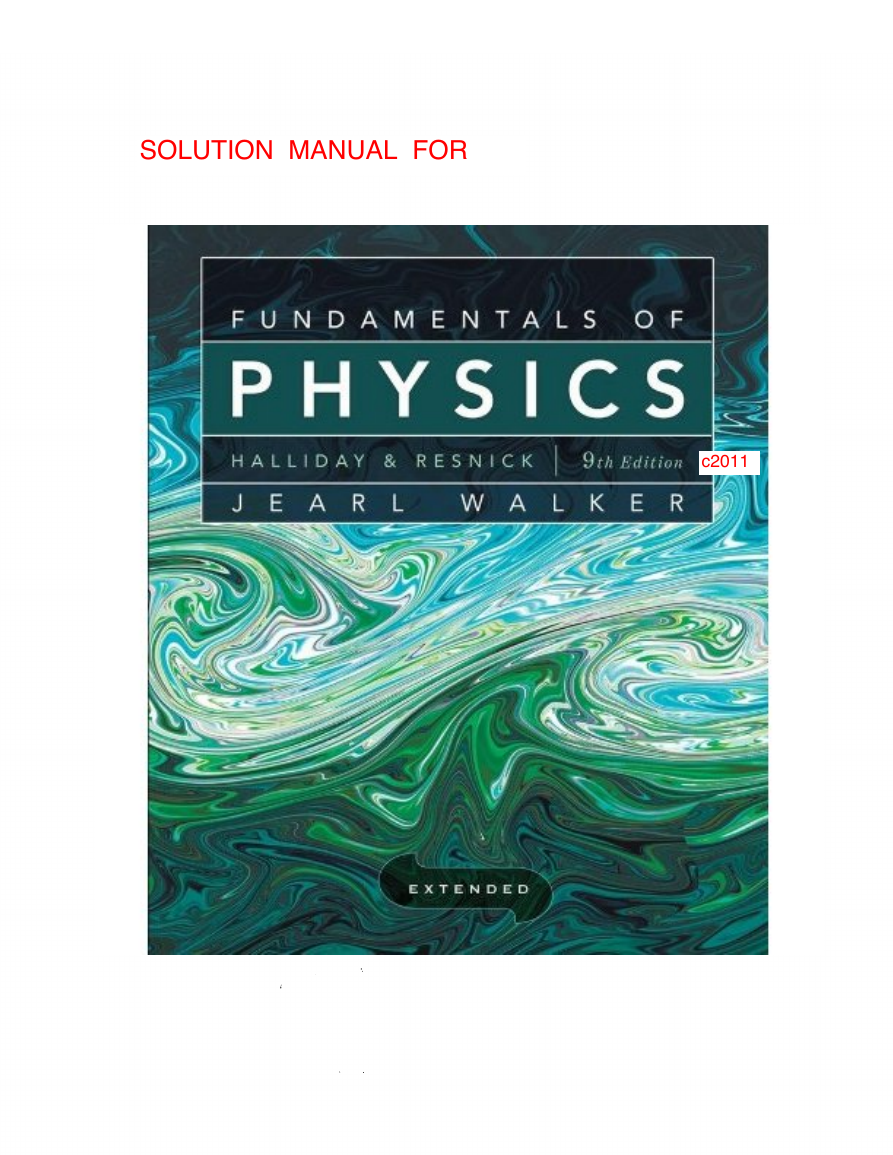
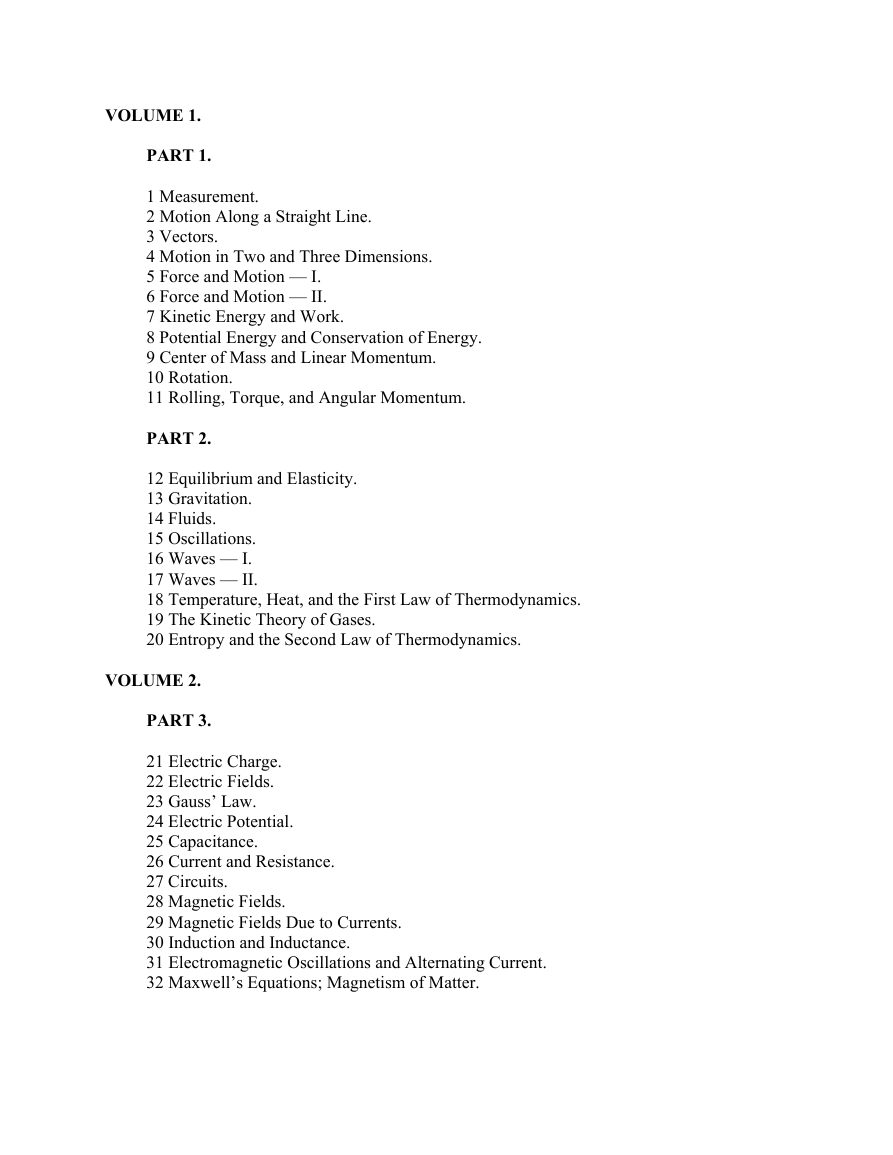
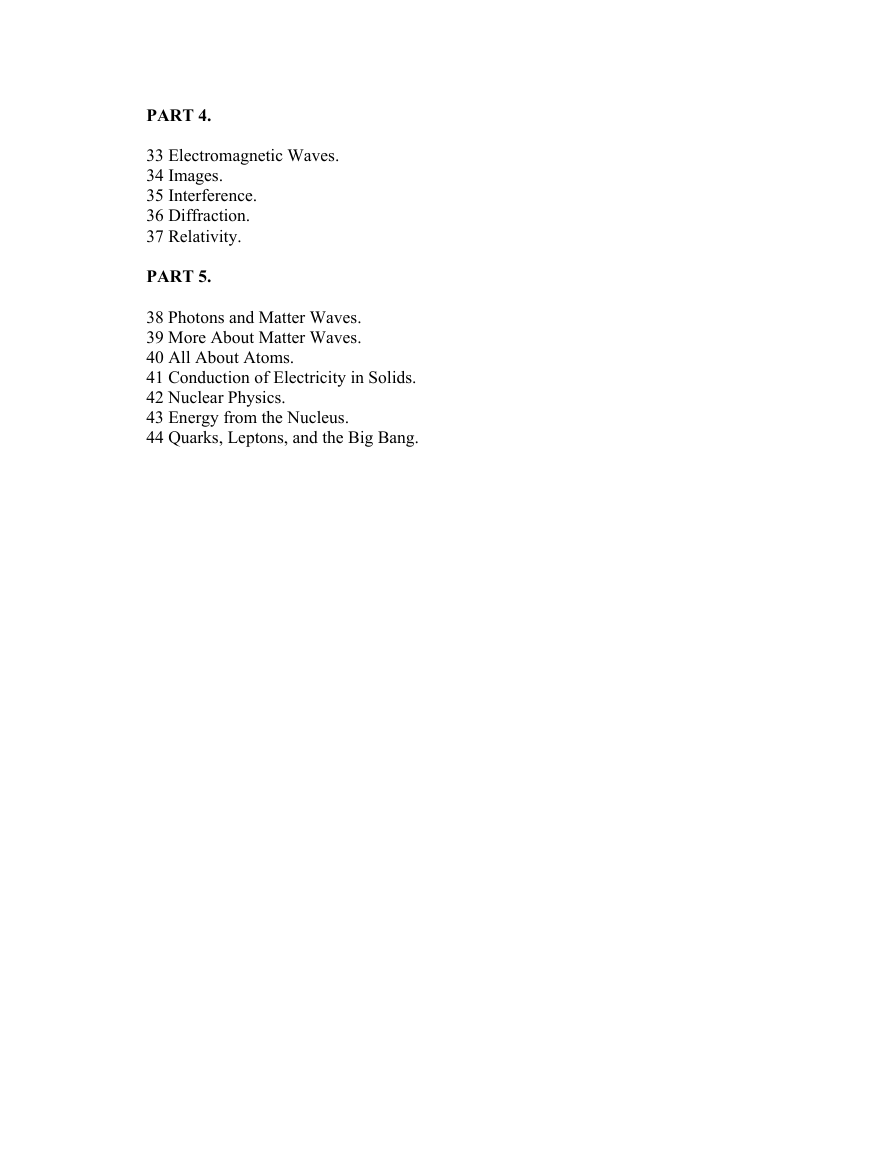
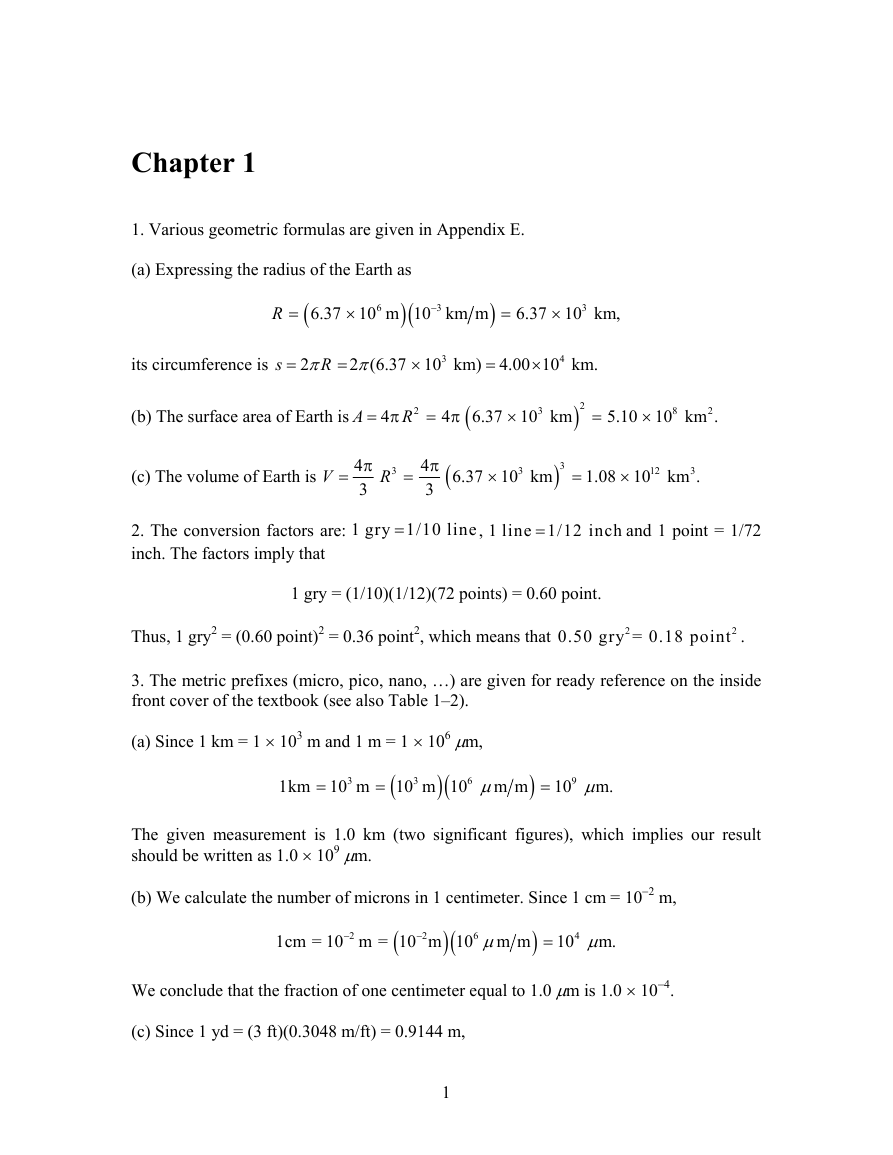
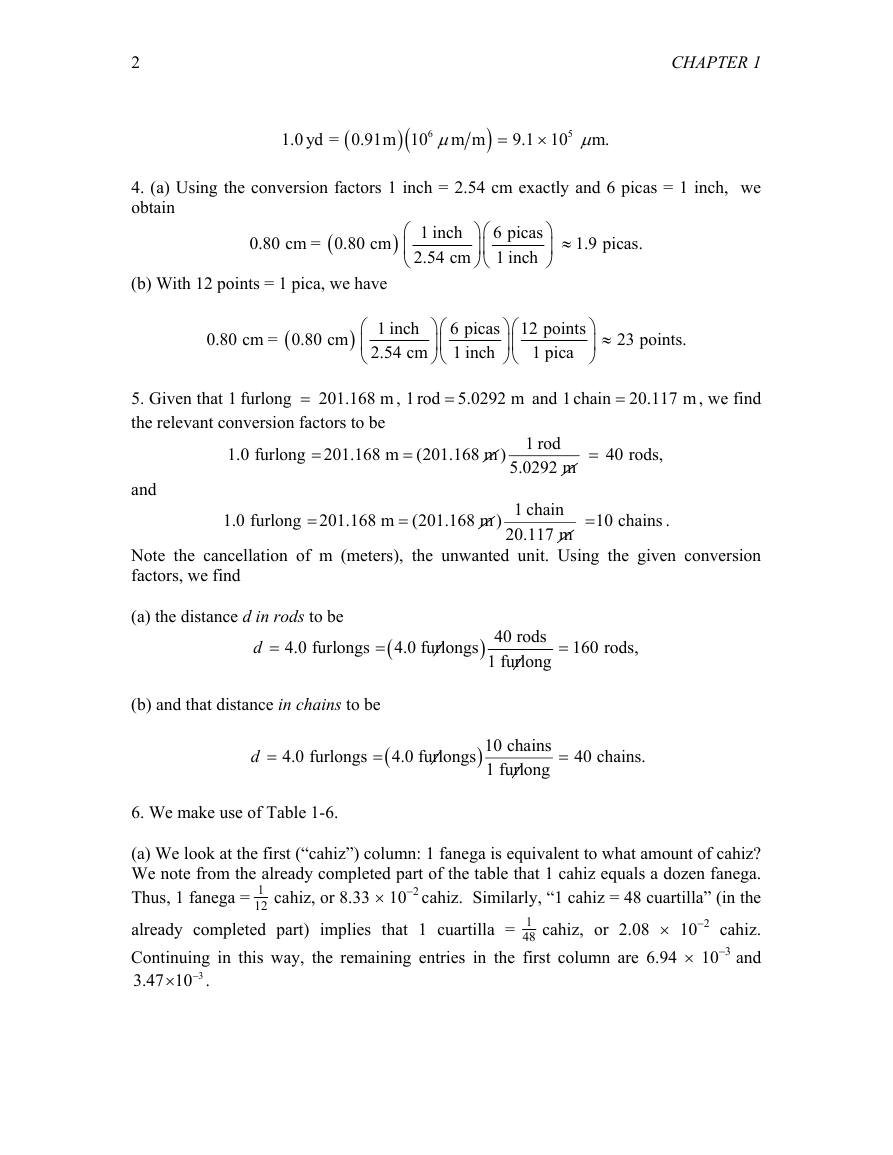
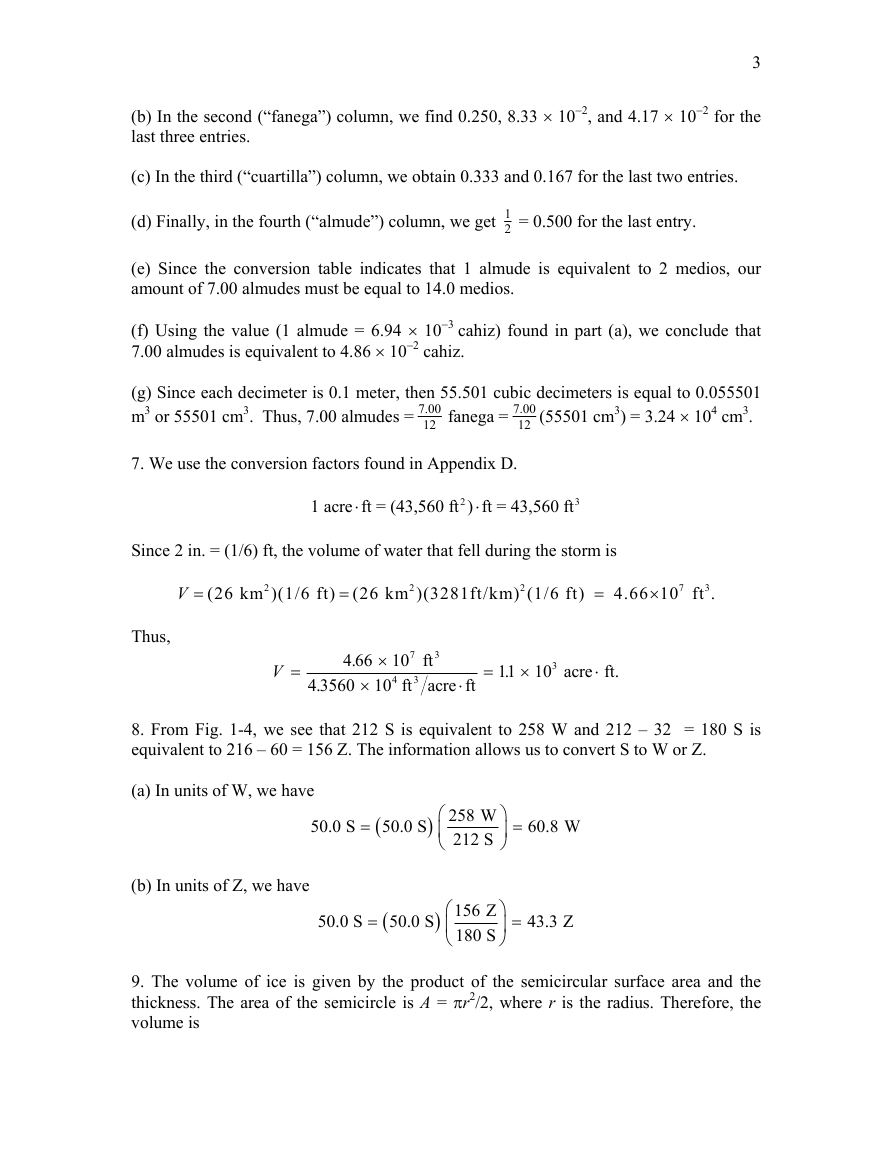
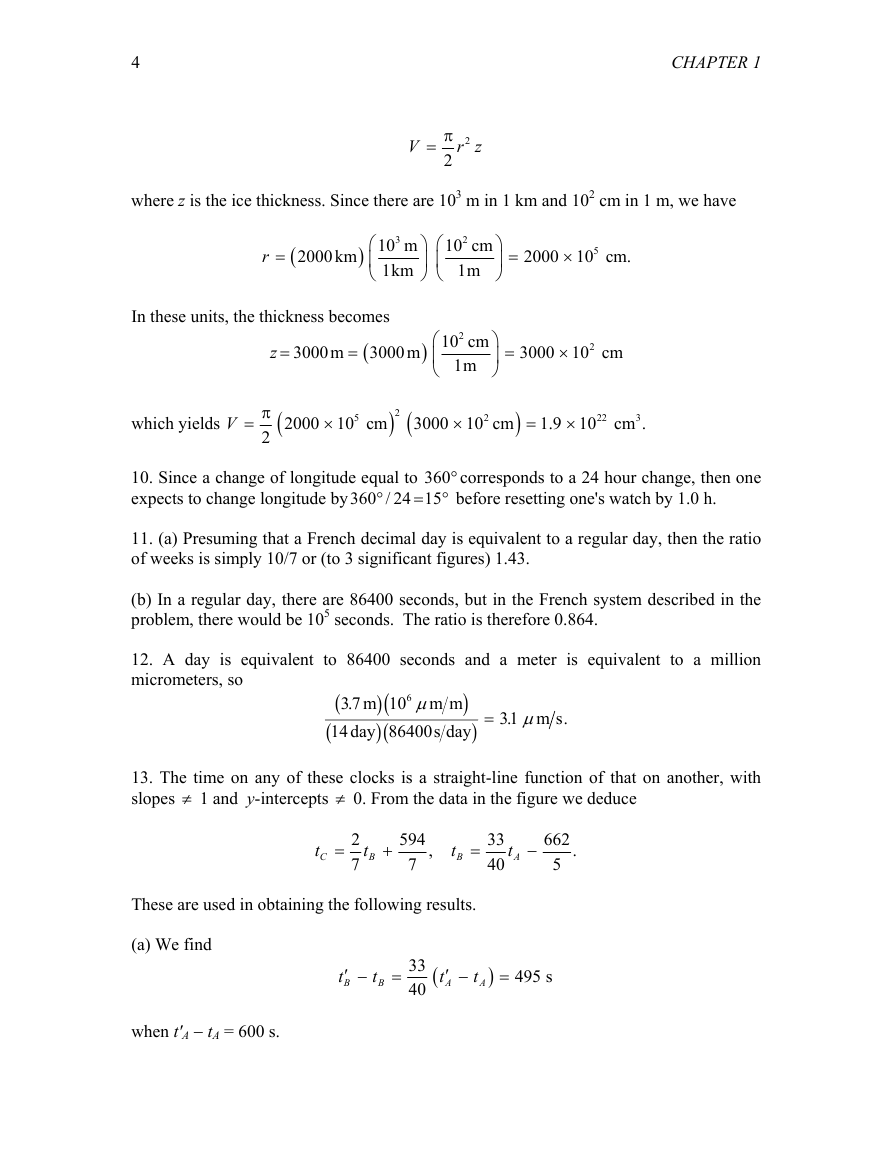
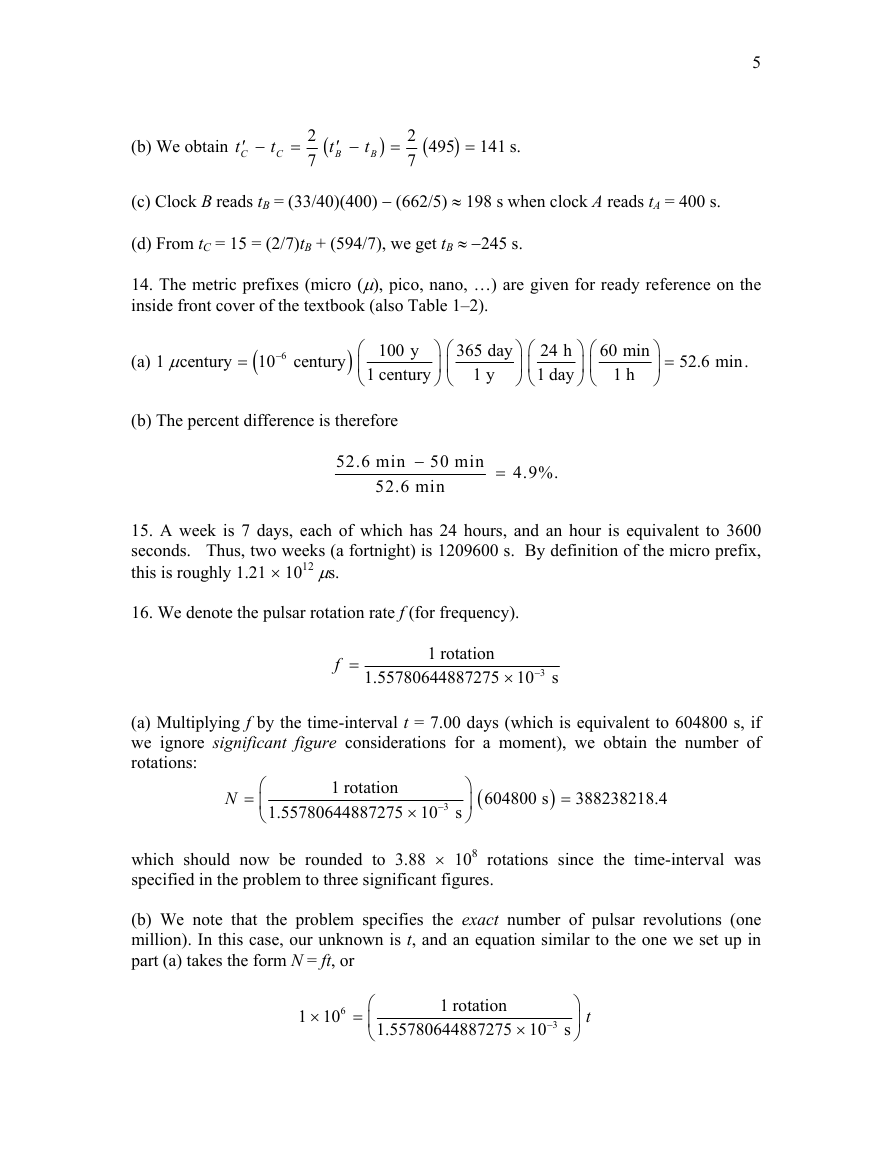








 2023年江西萍乡中考道德与法治真题及答案.doc
2023年江西萍乡中考道德与法治真题及答案.doc 2012年重庆南川中考生物真题及答案.doc
2012年重庆南川中考生物真题及答案.doc 2013年江西师范大学地理学综合及文艺理论基础考研真题.doc
2013年江西师范大学地理学综合及文艺理论基础考研真题.doc 2020年四川甘孜小升初语文真题及答案I卷.doc
2020年四川甘孜小升初语文真题及答案I卷.doc 2020年注册岩土工程师专业基础考试真题及答案.doc
2020年注册岩土工程师专业基础考试真题及答案.doc 2023-2024学年福建省厦门市九年级上学期数学月考试题及答案.doc
2023-2024学年福建省厦门市九年级上学期数学月考试题及答案.doc 2021-2022学年辽宁省沈阳市大东区九年级上学期语文期末试题及答案.doc
2021-2022学年辽宁省沈阳市大东区九年级上学期语文期末试题及答案.doc 2022-2023学年北京东城区初三第一学期物理期末试卷及答案.doc
2022-2023学年北京东城区初三第一学期物理期末试卷及答案.doc 2018上半年江西教师资格初中地理学科知识与教学能力真题及答案.doc
2018上半年江西教师资格初中地理学科知识与教学能力真题及答案.doc 2012年河北国家公务员申论考试真题及答案-省级.doc
2012年河北国家公务员申论考试真题及答案-省级.doc 2020-2021学年江苏省扬州市江都区邵樊片九年级上学期数学第一次质量检测试题及答案.doc
2020-2021学年江苏省扬州市江都区邵樊片九年级上学期数学第一次质量检测试题及答案.doc 2022下半年黑龙江教师资格证中学综合素质真题及答案.doc
2022下半年黑龙江教师资格证中学综合素质真题及答案.doc